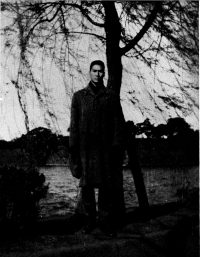Woke up this morning early for our trip to Kamakura, exactly one hour from Tokyo Station.
Hachimangū Shrine. A police officer in plainclothes from the Kamakura Police Station was our guide for sight-seeing. The Hachimangū Shrine is a historic place of worship, and, like the one at Nagano, there are sacred doves here, too. The temple buildings are the typical Japanese shrines painted in red. The official in charge of the grounds (an official from the Imperial Household Ministry) received us, delivered a speech, and posed for a picture on the steps of the shrine.
Daibutsu. Our next visit was to the famous Daibutsu or Great Buddha, a few minutes’ streetcar ride from the Hachimangū shrine. The statue of bronze, said to be 700-odd years old, has a dignified appearance in its huge dimensions. We went inside the Buddha and ascended a stairway up to the shoulders of the statue. A notice inside the image reads as follows: “Stranger, whosoever thou art and whatsoever thy creed be, when thou enterest this sacred statue remember this is a tathāgata, the womb of the cosmic body, and should be entered with reverence and not contamination.”
Kamakura Bathing Beach. At about 11:30 we took a nice swim at the famous beach of Kamakura, now packed with bathers seeking to escape the heat of Tokyo in summer. This is my first experience bathing in the Pacific Ocean, and my first, too, in Japanese waters. This part of the Pacific Ocean (Sagami Bay), I noticed, is rather cold, unlike the water in Pasay which is rather comfortably warm. Our beaches in Cavite, Bauan and Nasugbu are very much better than Kamakura’s, but the latter looks more like a tourist resort with bathing houses and beach umbrellas everywhere.
Enoshima Island is visible from the beach. It is reached by a wooden bridge from the mainland. Did not have time to go there.
Along the street leading to the beach are shops selling beautiful shell trinkets. Bought a few.
Yokohama. At 2:30 we were met at the Yokohama Station by another police officer in plainclothes who took us to the Kanagawa Prefectural Police Department, which occupies a beautiful building which is a landmark in Yokohama. Police Superintendent Nishihara, Chief of the Administration Section, who was at one time in the Philippines, received us in his office and posed for a picture in front of the building. We missed the parade of the Yokohama Emergency Police Unit which we were supposed to witness at 2:00.
At the Keisatsu Renshūjo (Police Training School), we visited the barracks and classrooms, and we were told all about the training. (In this school, Desiderio, Sinsuat and de Leon are undergoing training.)
Our next visit was to the Police Station of Isezaki. Here the Station Chief of Police showed us around the building and explained to us the workings of his office. From the roof garden of this station, we had a bird’s-eye view of Yokohama. This is a rather beautiful city with hills all around and a nice harbor.
Walking at Isezaki Street, which is Yokohama’s Ginza, we noticed how different Tokyo and Yokohama are. In the latter, there is not the conglomeration of people we see day in and day out in Tokyo. The shops are not very big, and traffic is not as heavy as in Tokyo.
When we reached the dormitory tonight at 8:00, we were all dead tired. This whole day has been very interesting. We saw so many places in such a short time.
